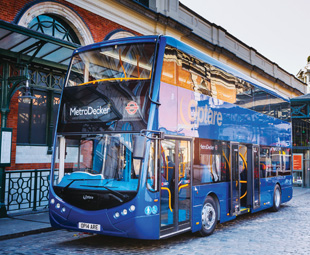Optare launches MetroDecker

FRANK BEETON brings us details on Optare’s new double-decker bus, and reports on Volvo’s attempts to revolutionise inner-city bus transport.
British bus builder, Optare, which is now a subsidiary of Indian manufacturer Ashok Leyland, launched its latest integral double-decker bus design at London’s Transport Museum in Covent Garden during May.
The MetroDecker utilises a combination of semi-stainless-steel body framing and lightweight components to achieve a tare mass of less than ten tonnes. It is powered by a Euro-6, 170 kW, four-cylinder, Mercedes-Benz OM934LA diesel engine. This drives through a fully automatic ZF Ecolife 6AP 10000B six-speed transmission, with integral hydrodynamic retarder. It rides on ZF fully independent airbag front suspension, and a ZF portal axle with four airbags at the rear.
The MetroDecker can accommodate 63 seated and 36 standing passengers, has a gross vehicle mass (GVM) rating of 18 t, and measures 10,5 (l) x 2,5 (w) x 4,31 m (h). It can accommodate multiple wheelchairs and has dual entrances; one alongside the driver and the other centrally located between the axles. Access to the upper deck is by way of a staircase situated immediately behind the driver.
The full-air, anti-lock service braking system, supplied by Knorr-Bremse, utilises disc brakes front and rear, with an air-released spring parking brake acting on the rear wheels.
Volvo to test “Electric Road”
Last month, we reported on new electric trolleybuses that were entering service in São Paulo, Brazil. This technology, while being more than a century old in its crudest form, is still attractive.
It cannot be denied, however, that trolleybus systems, with their overhead power supply catenary and multitude of supporting poles and cables, have a visual impact on the environment. Trolleybuses connected to the same line of power supply are also constrained by an inability to overtake one another, and, if not equipped with some form of alternative propulsion, are not capable of moving away from their fixed routes.
Although this lack of operational flexibility is less important in a bus rapid transit (BRT) type environment, it has led to the demise of trolleybuses in many countries.
The “Holy Grail” of electric passenger transport would of course be a system without environmental or operational compromise, and much work is currently being undertaken to achieve such an end.
One solution involves the use of inductive charging, in which the vehicle can acquire an electrical charge from beneath the road surface, with no need for physical contact between any part of the vehicle and the power supply.
Last year, we reported that Canadian transport specialist, Bombardier, was developing its Primove system, employing primary coils placed under the road surface, and secondary coils within the vehicle, which, on entering the magnetic fields created by the primary coils, receive the current and replenish the on-board batteries.
The Volvo Group is now following a similar direction, studying the potential for the use of “electric roads”. Working in conjunction with the Swedish Transport Administration, Volvo is developing a proposal to construct a 300- to 500-m electric road in its home town of Gothenburg during 2015.
The proposed programme will include building a section of road equipped with wireless charging technology, and vehicles that are equipped to receive the available charge while passing over the enabled section of road. The road will be part of an existing public transport route, to enable “real world” testing.
The retention of in-vehicle battery storage in the “electric road” project is interesting, given the extra mass of and space taken up by battery packs. Why not go directly to electric traction enabled by a permanent off-vehicle power supply? Well, there is logic in giving the vehicle some degree of mobility away from its power supply, in the event of system failure or road blockages.
It is also useful to be able to “shunt” vehicles in workshop areas without constant access to an external power supply. This technology is still in its infancy, however, and we expect that there will be much refinement as it progresses.
Published by
Focus on Transport
focusmagsa




